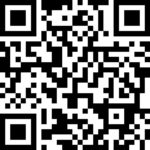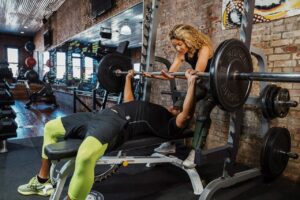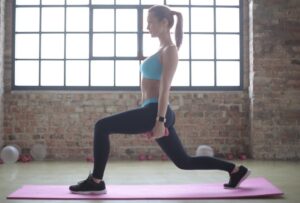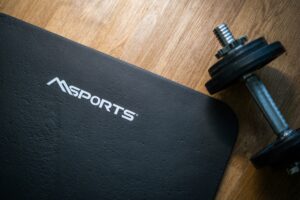Every trainee has unique preferences for the type of body they want to build at the gym.
Men generally want big arms, a broad back, cannonball shoulders, an armor plate chest, and washboard abs.
In contrast, women prefer a toned upper body with a flat stomach, well-shaped legs, and a heart-shaped butt.
The question is, can everyone achieve that specific look? If so, what would it take to get there?
Let’s find out.
Types of Butt Shapes
Four primary shapes classify most butts:
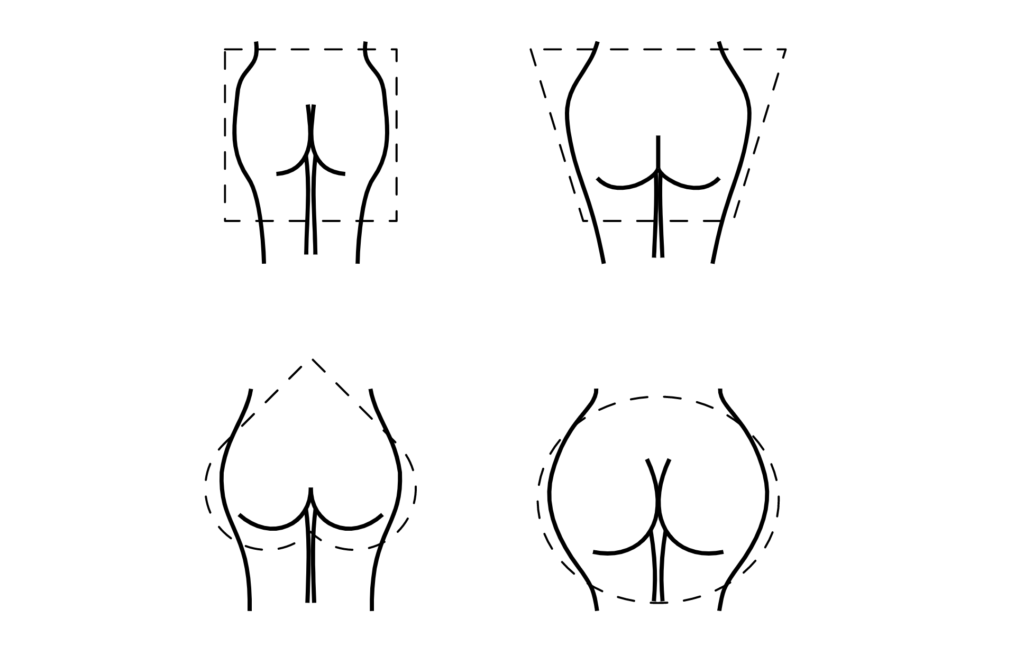
1. Square Bum (H-Shaped Butt)
A square behind is one of the most common and least desired shapes. The type of butt resembles the letter H seen from the back and appears flat from the side.
It generally results from a square pelvic bone shape, underdeveloped glute muscles, and fat covering the hips and lower back.
2. Round Bum (O-Shaped Butt)
A round bum is much more desirable than a square butt and more challenging to achieve. It resembles the letter O when seen from the back and looks curvy from the side.
People with a round behind can thank their genetics for determining the shape. A round bum largely depends on more even fat distribution in the gluteal region. In addition, developed glute muscles further contribute to the shape.
A round behind is highly beneficial because it looks great and makes the thighs and waist appear smaller.
3. Inverted Bum (V-Shaped Butts)
Like the square behind, an inverted butt is also relatively common and undesirable. The butt type resembles the letter V when seen from the back and often appears flat from the side.
More mass (muscle and fat) in the upper area and low muscular development in the middle and lower region results in an inverted butt. As a result, the inverted butt is wider and rounder at the top but narrower and flatter at the bottom.
4. Heart-Shaped Butt
Finally, we have the heart-shaped butt: one of the most desired butt types. As its name suggests, a heart-shaped butt resembles the shape of a heart when seen from the back. Plus, similar to a round behind, it appears curvy from the side.
Decent gluteal development, even body fat distribution in the area, and a relatively narrow waistline contribute to a heart-shaped butt. (It’s important to note that your genetics decide your exact butt shape.)
A high-protein diet coupled with resistance training will develop your glute muscles. But body fat distribution, muscle shape and insertions, and hip bone shape will determine whether you get a round or heart-shaped butt.
Hevy User Testimonial
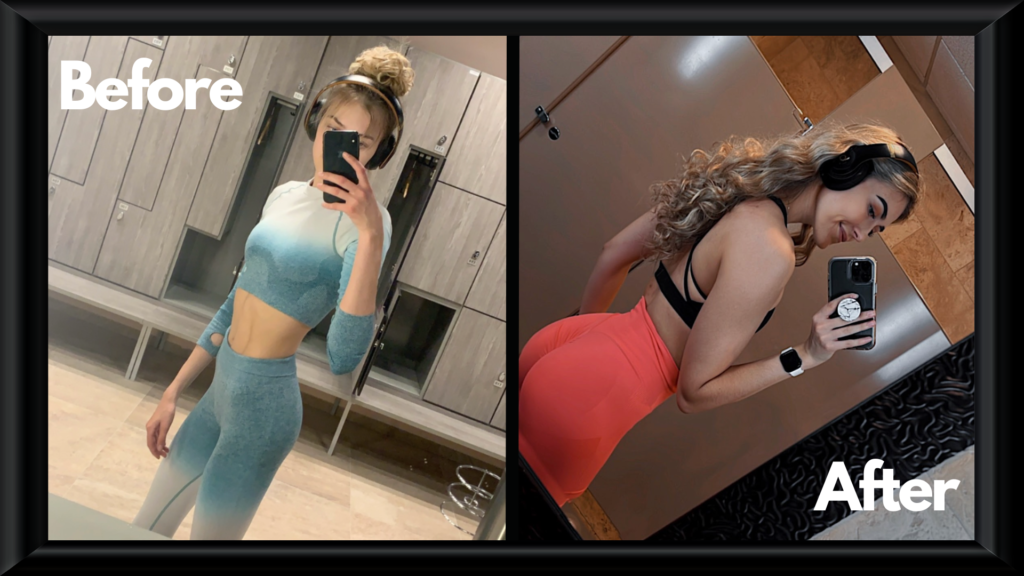
“I’ve been struggling with back problems, scoliosis to be exact since I was in grade 4, I had my back operated in 2013. I was always the skinny girl, borderline anorexic, even though I ate more than most. For a long while I tried to workout here and there but found it hard to find motivation since I wasnt seeing results in regards to bodyweight. Finally, 2 years back I signed up with a personal trainer who wrote me workout and meal plans and recommended tracking my workouts through the Hevy App. Since then, I’ve gained 30 pounds, look and feel much healthier, and I’m in the best shape of my life. The plan is to keep growing lean muscle and potentially enter competitions when I’ve improved enough. Tracking has definitely helped with all that since now I can visualize the progress by seeing the charts and personal records breaking; it’s been awesome.”
-Charlotte (Hevy user)
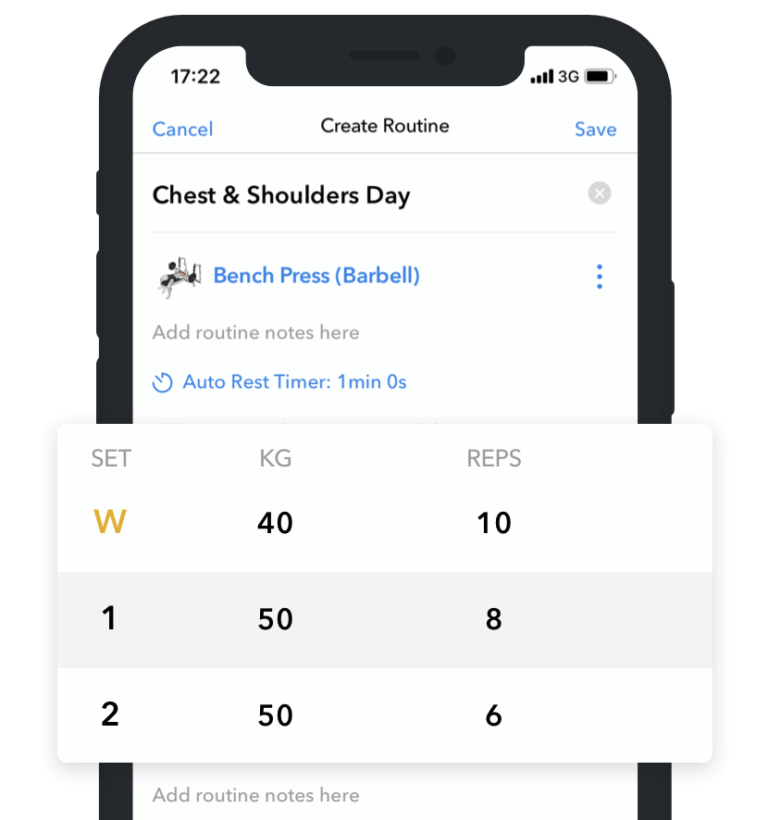






Hevy – Workout Tracker
Create and log your heart shaped butt workout with Hevy, and track your progress
What Factors Affect Your Butt Shape?
As briefly mentioned above, several factors affect your butt shape and overall size, regardless of lifestyle choices. These include:
- Hip bone size and shape
- Muscle shape, length, and insertion points
- Body fat distribution patterns
For instance, we know that the lower portion of the gluteus maximus inserts into the gluteal tuberosity of the femur (the large thigh bone) (1). If the muscle inserts higher on the femur, that will make it slightly more narrow, leading to a round butt appearance.
Similarly, body fat distribution plays a huge role in your butt shape. Some people enjoy more even distribution, which can contribute to a rounder butt. In contrast, others carry fat in a specific region (e.g., the upper or lower portion of the butt), which affects the shape.
For example, having more fat in the upper area contributes to the inverted butt look, whereas too much fat in the lower region can lead to a saggy butt appearance.
The final major factor is hip bone size and shape. For example, a square hip bone makes for a square-shaped butt.
Fortunately, good nutrition and the right butt exercises can significantly impact the area’s appearance, leading to a rounder, firmer, and stronger behind.
10 Glute Exercises For a Heart-Shaped Butt
1. Deep Squats
Equipment: external weight (dumbbell, kettlebell, barbell, etc.)
Muscles worked: quadriceps, hamstrings, glutes, adductors, midsection


How to (bodyweight):
- Stand tall with your shoulders back, feet hip-width apart, and toes pointed slightly out.
- Raise your arms in front of your body for balance, take a deep breath, and engage your abs.
- Descend into a squat while keeping your heels planted on the floor.
- Your thighs should be slightly below parallel to the floor at the bottom position.
- Pause for a moment and press through your heels to bring yourself to the top position as you exhale.
Pro tip:
Taking time to warm up the hips and ankles could make achieving adequate depth and maintaining balance easier.
Leg swings are an excellent dynamic movement to mobilize the hip joint, and deep squat holds further mobilize the area and stretch the adductors (inner thigh muscles).
You can do a simple wall stretch for your ankles. Stand tall, stagger your stance, and keep your front foot a few inches away from the wall. Once in position, press into your front ankle, driving the knee as far forward as possible while keeping your heel on the floor.
Stretch and release up to ten times per leg and finish with simple ankle circles to prepare the joint.
Related article: The Top Dumbbell Leg Workouts to Attain Powerful Legs
2. Barbell Hip Thrust
Equipment: flat gym bench, barbell, weight plates, barbell pad
Muscles worked: glutes, hamstrings, lower back, quadriceps, midsection
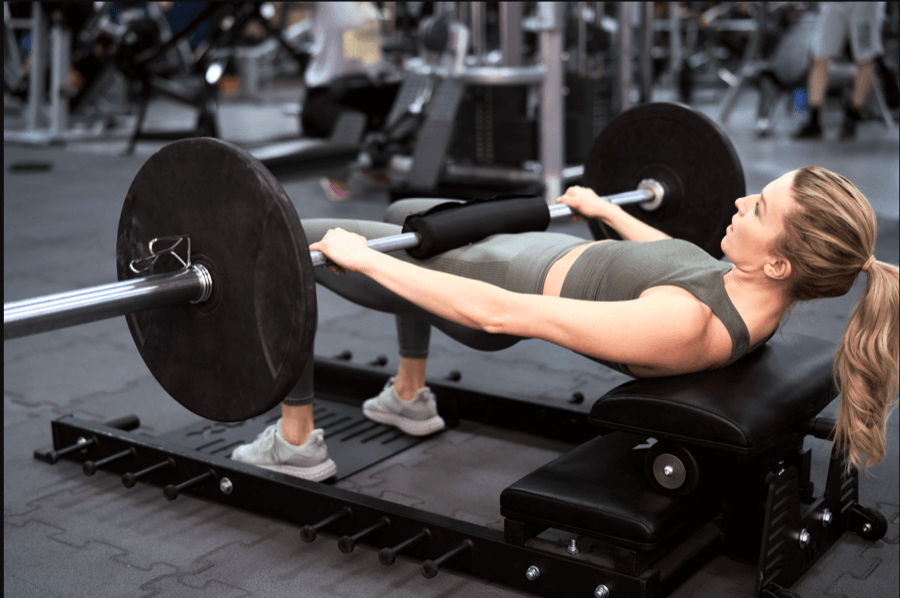

How to:
- Sit on the floor with a flat gym bench behind your back and a loaded barbell over your hips.
- Lean back and position your upper back against the edge of the flat bench.
- Bend your knees and plant your feet flat on the floor, pressing the crease of your hips against the barbell.
- Retract your shoulder blades, take a deep breath, and engage your midsection.
- Drive your heels into the floor and squeeze your glutes to lift the barbell toward the ceiling.
- Raise the bar until your knees, hips, and shoulders align horizontally.
- Pause briefly and slowly lower your buttocks to the floor as you exhale.
Pro tip:
Some trainees struggle to feel their glutes during hip thrusts and often feel most of the tension in their hamstrings and quadriceps. A good cure for that is to take some time to activate your glutes before hip thrusts.
For instance, you can do lateral band walks, which we will discuss below, and consciously engage your buttocks muscles on each repetition. Then, when you sit down for hip thrusts, you might find it easier to form a mind-muscle connection.
3. Glute Bridge
Equipment: exercise mat
Muscles worked: glutes, hamstrings, lower back, quadriceps, midsection
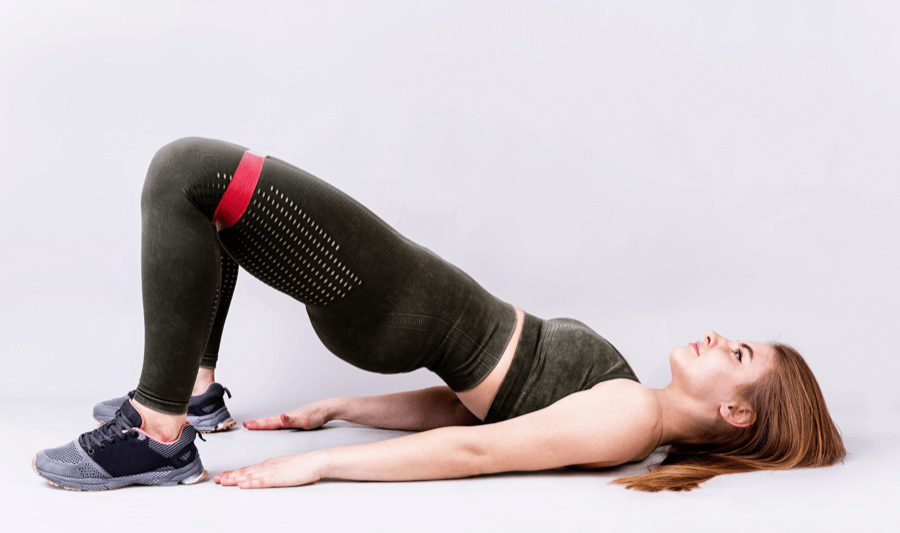

How to:
- Place an exercise mat on the floor and lie down.
- Bend your knees and plant your feet flat on the floor.
- Straighten your arms and place your hands flat on the ground to your sides for balance.
- Take a deep breath in your belly and engage your abs.
- Press through your heels and squeeze your glutes to drive your hips toward the ceiling.
- Drive your hips up until your knees, hips, and shoulders are in a straight line.
- Pause at the top for a moment and slowly lower your buttocks to the floor as you exhale.
Pro tip:
Glute bridges are excellent for beginners but become too easy after a while. Adding external weight is one effective way to make the exercise more challenging. For instance, you can support a dumbbell over your hips while doing the exercise.
You can also wrap a mini resistance band over your thighs, just above your knees, striving to keep it stretched while performing glute bridges. Doing so can lead to better glute activation.
4. Romanian Deadlift (Barbell, Dumbbell)
Equipment: a barbell with weight plates or a pair of dumbbells
Muscles worked: hamstrings, glutes, back, midsection, arms, shoulders
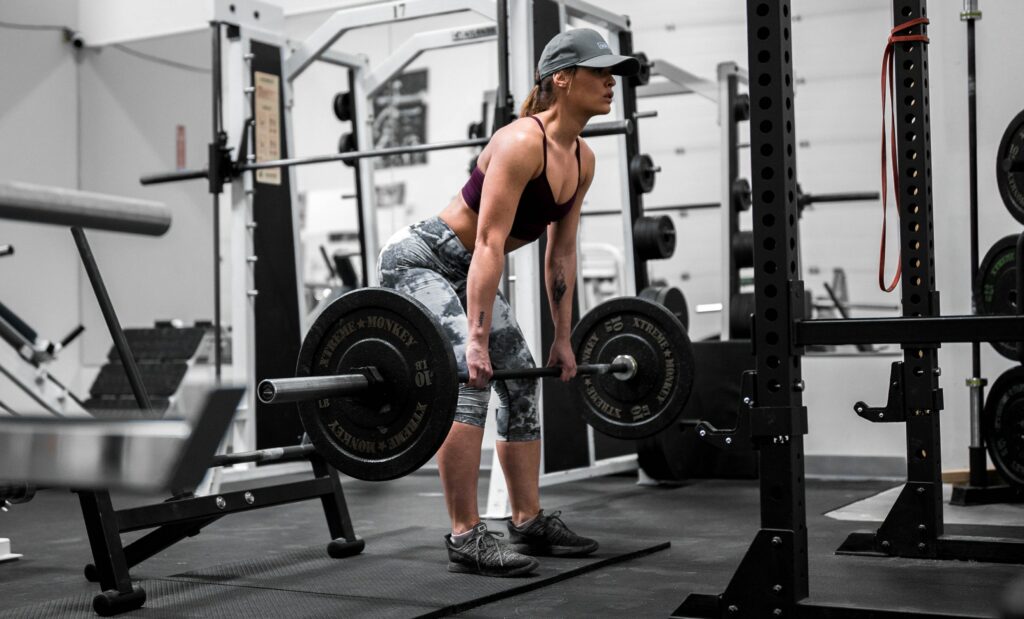

How to (dumbbells):
- Grab a pair of dumbbells and stand tall with your shoulders back, feet hip-width apart, and toes pointing slightly out.
- Take a deep breath and engage your abs.
- Push your buttocks back, leaning your torso forward while keeping your back straight. Your heels should be in contact with the floor at all times.
- Slowly lean forward until your torso is roughly parallel to the floor. You should feel a significant stretch in your posterior chain.
- Drive your hips forward to stand up and squeeze your glutes to complete the rep. Exhale.
Pro tip:
Do slow and controlled reps, striving to engage your glutes as you stand up at the end of each repetition.







Hevy – Workout Tracker
Create and log your heart shaped butt workout with Hevy, and track your progress
5. Hip Abduction (Machine)
Equipment: hip abduction machine
Muscles worked: gluteus medius and minimus, tensor fasciae latae, midsection
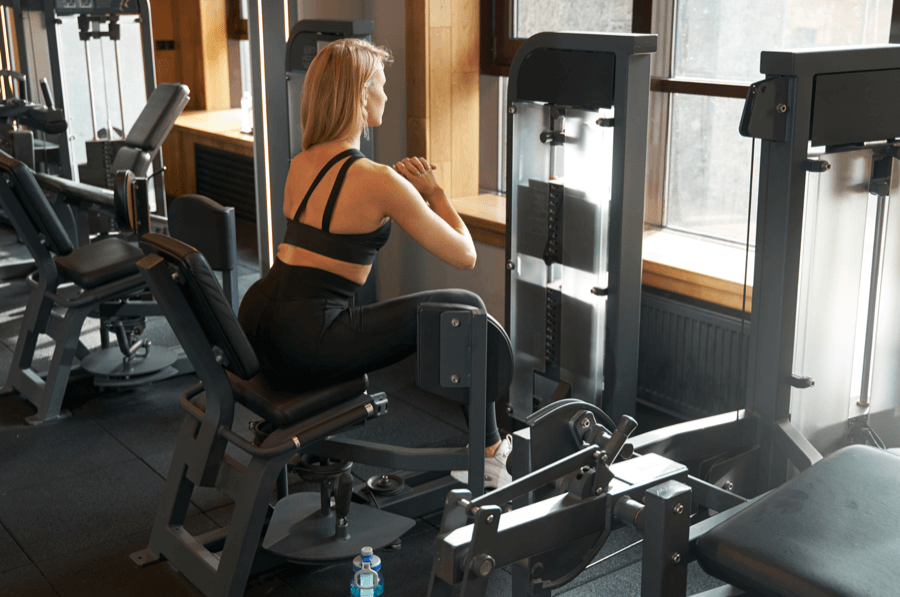

How to:
- Select the appropriate load and sit on the machine.
- Place your feet on the footplates and position the outer portion of your thighs against the pads. Your knees should be together.
- Take a deep breath, engage your abs, and spread your legs in one fluid motion.
- Pause for a moment and bring your knees together as you exhale.
Pro tip:
A simple way to make the exercise more useful and build heart-shaped glutes is to pick a lighter weight and do slow and controlled reps. The hip abductor muscles are relatively small and cannot produce that much force.
A lighter load allows you to engage these muscles more effectively and keep the tension on them. Aim for up to 15-20 slow and controlled reps.
Related article: 5 Isolation and 9 Glute Compound Exercises for a Head-Turning Behind
6. Clamshell
Equipment: exercise mat
Muscles worked: gluteus medius and minimus, tensor fasciae latae
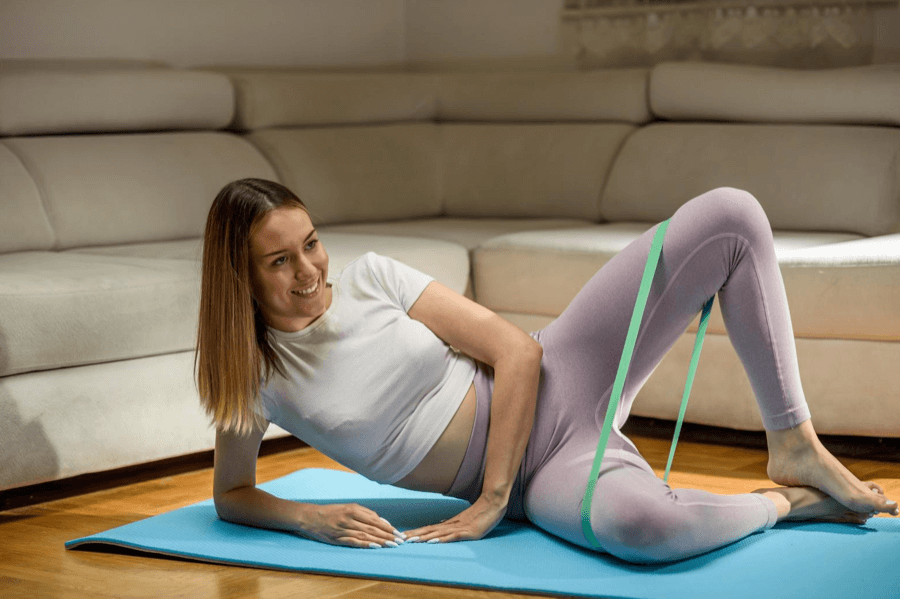

How to:
- Lie on your left side with your knees bent, feet together, and legs stacked.
- Raise your torso slightly and bend your left arm to support your head and prevent neck strain.
- Engage your abs and take a deep breath.
- Lift your top knee in one fluid motion while keeping your feet together and your bottom leg on the floor.
- Pause for a moment and slowly lower the knee to the starting position. Exhale.
- Once finished, lie on your right side and do the same number of reps.
Pro tip:
Clamshells can contribute to a heart-shaped booty, but you must learn to overload the exercise as you get stronger. A straightforward way to do so is by looping a mini band over your knees. Doing so would provide extra resistance and contribute to muscle activation.
Related article: 10 Exercises to Turn Your Square Butt into a Round Behind
7. Fire Hydrant
Equipment: exercise mat
Muscles worked: gluteus medius and minimus, tensor fasciae latae, midsection, shoulders, arms
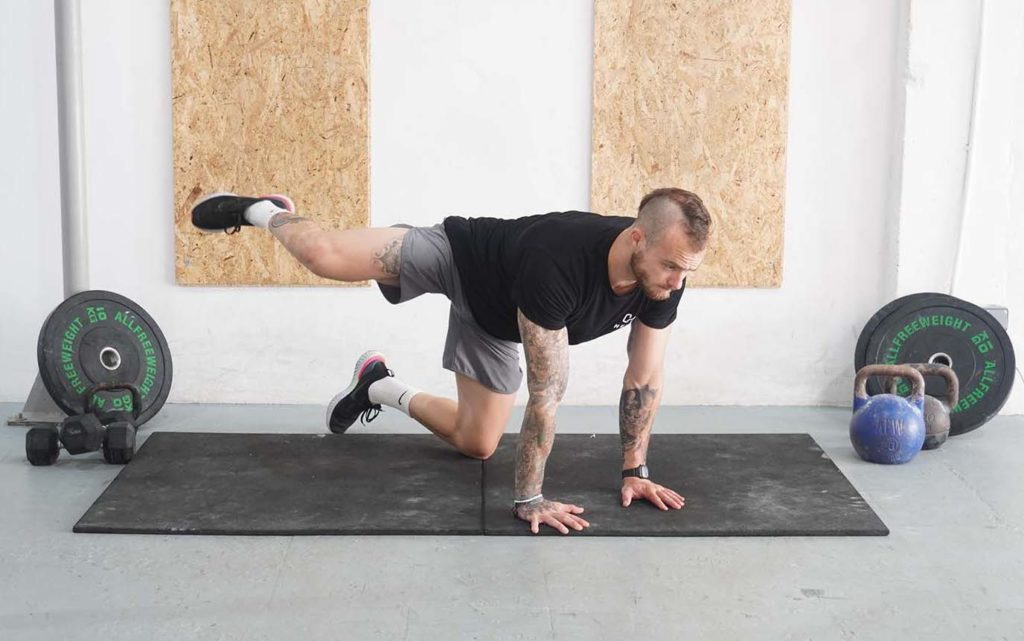

How to:
- Place an exercise mat on the floor and get down on all fours. Straighten your arms and place your hands flat on the floor.
- Bend your knees at a 90-degree angle and retract your shoulder blades.
- Take a deep breath, engage your abs, and shift your weight slightly on the left knee.
- Raise your right leg laterally in one fluid motion while keeping the knee bent.
- Pause at the top position for a moment, trying to engage your upper glutes. You should feel the tension in your outer thigh and glute.
- Slowly lower your leg to the starting position as you exhale.
- Once finished, shift slightly to the right and do the same number of reps with your left leg.
Pro tip:
Like clamshells, fire hydrants are a unilateral exercise that can become more challenging and build muscle mass if you loop a mini resistance band over your thighs.
Pick a lighter band that allows you to perform smooth repetitions through a full range of motion.
8. Glute Kickback (Machine)
Equipment: glute kickback machine
Muscles worked: glutes, hamstrings, quadriceps, midsection
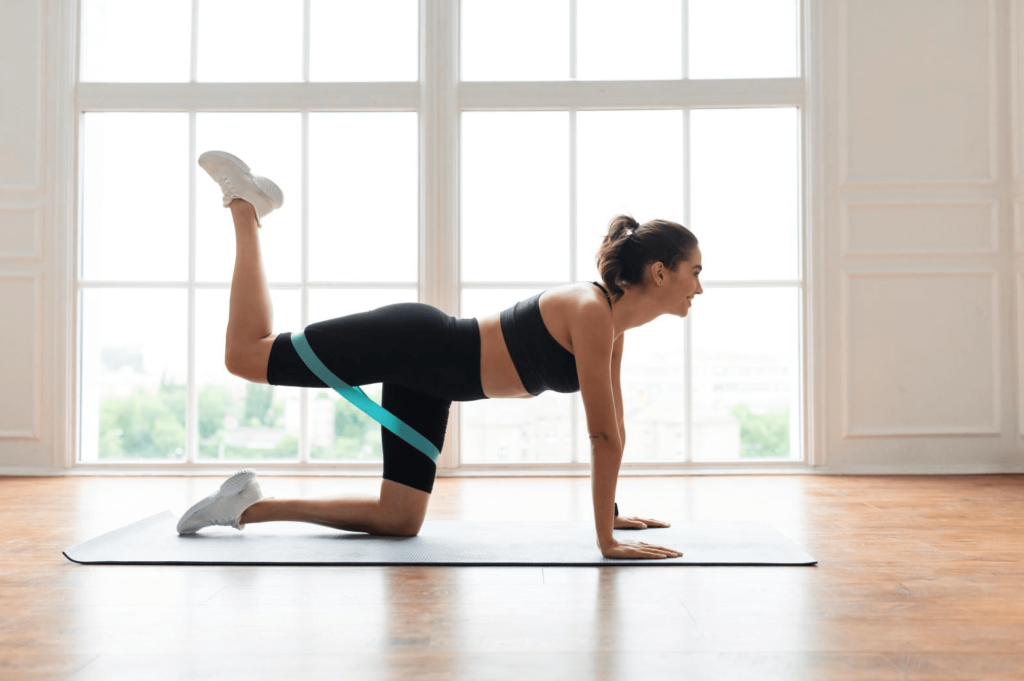

How to:
- Select the appropriate load on the machine
- Get on the platform, lean forward, and grab the handles.
- Extend one leg back, placing the foot flat against the footplate. Keep your opposite foot on the ground.
- Take a deep breath and engage your abs.
- Drive your leg back in one fluid motion, straightening your knee and squeezing your glute muscle.
- Pause for a moment and slowly bend your leg as you exhale.
- Once finished training one side, switch feet and do the same number of reps.
Pro tip:
For heart-shaped glutes, use a lighter load and do each repetition slowly and with good body control. Feel the glute muscle engage on each repetition and stop the set when you feel an intense burn in the three gluteal muscles.
9. Reverse Hyperextension
Equipment: reverse hyperextension machine/bench
Muscles worked: glutes, hamstrings, lower back, midsection
How to:
- Stand in front of a reverse hyperextension machine or bench.
- Position your feet inside the pads.
- Lie on top of the hyperextension machine and grab the handles for support. The posterior pad should be against your Achilles heel, and your stomach should be flat on the top platform.
- Take a deep breath and engage your abs.
- Raise your legs back in one fluid motion, squeezing your glutes at the top. Your shoulders, hips, and lower body should be in horizontal alignment.
- Slowly lower your legs to the bottom position and exhale.
- Immediately take another breath and perform another rep.
Pro tip:
Though most people see reverse hyperextension as a hamstring exercise, it primarily works the glute muscle group through hip extension, similar to a conventional deadlift (2). To take full advantage, maintain a rhythmic pattern, generating some momentum as you lower your legs and using it for the next repetition.
In addition to helping build heart-shaped butts, the activity is excellent for mobilizing the spine and potentially helping with certain conditions. Still, it is best to consult a professional if you have spinal issues and avoid self-treatment.
10. Lateral Band Walks
Equipment: looped resistance band or mini band
Muscles worked: glutes, tensor fasciae latae, midsection
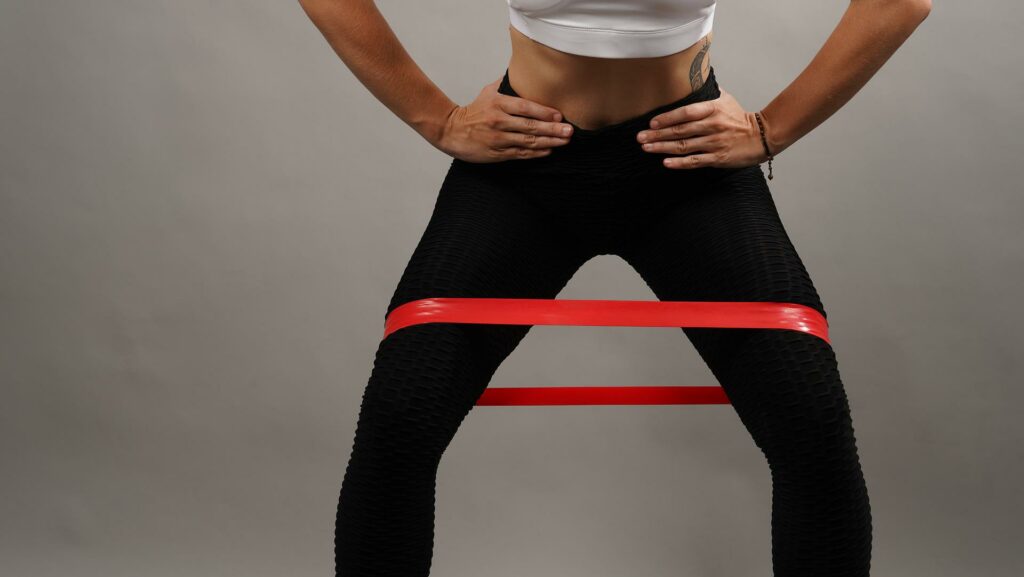

How to:
- Wrap a mini resistance band just above your ankles or knees.
- Stand tall with your shoulders back, feet hip-width apart, and toes pointing slightly out.
- Lean your torso slightly forward and maintain a slight bend in your knees.
- Optional: Extend your arms in front of your body for balance.
- Take a breath, engage your abs, and step to the right as you exhale.
- Inhale again and take another step in the same direction.
- Take up to 20 steps to the right, switch your direction and walk to the left.
Pro tip:
Lateral band walks might not seem like the best exercise, but they can make training the glutes more effective and help with building muscle.
Specifically, you can do the exercise before your glute workouts to warm up and improve the mind-muscle connection. Pick a light band and focus on proper glute engagement on every step.
Simple And Effective Workouts For Heart-Shaped Glutes
Here are a couple of simple glute-building workouts for a heart-shaped behind. You can do both of these within a week, so long as you give your muscles at least 48 hours to recover (3).
For example, you can do the first workout on Monday and the second on Thursday.
| Glute Workout 1 | |||
| Exercise | Sets | Reps | Rest period |
| Barbell Hip Thrust | 4 | 10-15 | 1.5-2.5 mins |
| Romanian Deadlift (Dumbbell) | 3 | 10-15 | 1.5-2 mins |
| Glute Kickback (Machine) | 3 | 12-20 | 1.5-2 mins |
| Clamshell | 3 | 15-25 | 1-1.5 mins |
| Glute Workout 2 | |||
| Exercise | Sets | Reps | Rest period |
| Romanian Deadlift (Barbell) | 4 | 8-12 | 2-2.5 mins |
| Glute Bridge | 3 | 15-20 | 1.5-2 mins |
| Hip Abduction (Machine) | 3 | 15-20 | 1.5-2 mins |







Hevy – Workout Tracker
Create and log your heart shaped butt workout with Hevy, and track your progress
Frequently Asked Questions (FAQs)
1. Can you change the shape of your bum?
It depends on the person and their unique situation. For example, people with low muscular development who store fat in certain areas can change their bum shape. Specifically, a person can lose fat and gain some muscle, leading to a round-shaped butt.
If your current body fat percentage is too high (over 17-18 percent for men and over 26-28 percent for women), strive to lose fat before anything else.
Unfortunately, there isn’t anything you can do to change your bone structure.
2. Do squats make your butt bigger?
Many women do squats several times per week to attain heart-shaped butts. While the exercise builds muscle mass, it generally isn’t the best one for the glutes.
Deep squats are perhaps the only decent variation that promotes glute growth, but fixing square-shaped butts requires other movements: hip thrusts, glute kickback, etc. (4, 5)
Don’t forget to maintain a slight calorie surplus and aim for steady weight gain to increase your bum size through resistance exercise (6).
3. How to tone my butt?
Toning your butt and any other body part comes down to two things:
- Building muscle
- Losing fat
First, build the glute area by picking several effective exercises and focusing on progressive overload: doing more challenging training over time.
Second, lose excess fat by maintaining a moderate calorie deficit, consuming enough protein, and getting at least seven hours of sleep per night (7, 8).
Be consistent with these two objectives, and you will tone your butt within a few months to a year, depending on your starting point.
Final Thoughts
Attaining a heart-shaped butt comes down to having the right genetics (body fat distribution, bone structure, muscle shape, insertions, etc.) and maximizing them through proper training and good nutrition.
While not everyone can achieve a textbook heart-shaped bum, most people can develop a head-turning behind. Follow our tips, do the exercises from our list, and you will do great.
For further support on structuring and logging your workouts, check out the Hevy app.

